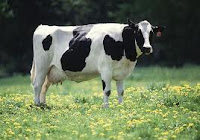
What comes out of the back end of a cow?
Milk and manure. The cows at the Audet family's Blue Spruce Farm make almost 9,000 gallons of milk a day — and about 35,000 gallons of manure. With the help of their power company, Central Vermont Public Service Corp., the Audets have devised a way to extract methane from the manure and pipe it to a generator. They make enough electricity to power 300 to 400 average Vermont homes.
How can electricity be made from cow manure?
If cow manure is pushed into a long, narrow tank and held around 100 degrees, in about 20 days bacteria will digest the manure into methane gas and a liquid slurry. The methane can run an engine and generator to make electricity. A dry, odor-free, fluffy brown substance that is used as bedding for the cows can also be extracted. The remaining liquid contains enough nutrients that it can be used as fertilizer for the farm's feed crops.
Do farms in Minnesota make electricity from manure?
Since late 1999, the Haubenschild farm has been converting their cow manure into electricity. At first they, too, digested manure producing methane which fueled a generator to produce electricity. Then, on Jan. 27, 2005, for the first time anywhere in the world, the methane was fed into a fuel cell.
A fuel cell is like a battery. A chemical reaction generates the electricity. It is totally quiet, and the only waste product is clean water. Haubenschild said it costs 5.1 cents per kilowatt hour to produce electricity from the fuel cell and Great River Energy will buy the surplus electricity from the fuel cell for four cents per KWH. If Minnesota power companies can create a progam similar to Vermont's Cow power program, customers willing to pay a couple extra cents per KWH would allow farmers to make money instead of losing money.
A fuel cell is like a battery. A chemical reaction generates the electricity. It is totally quiet, and the only waste product is clean water. Haubenschild said it costs 5.1 cents per kilowatt hour to produce electricity from the fuel cell and Great River Energy will buy the surplus electricity from the fuel cell for four cents per KWH. If Minnesota power companies can create a progam similar to Vermont's Cow power program, customers willing to pay a couple extra cents per KWH would allow farmers to make money instead of losing money.
cow power facility located on the 1,200-cow farm
animal waste-to-energy portfolio can generate 300 kilowatts of electricity to power 220 homes. Most of the anaerobic manure digester facilities in the Dairyland system can generate 775-840 kilowatts of energy, enough to power at least 600 homes.
How does animal waste-to-energy work?
Cow manure is collected and heated in the digester tank, a process that creates methane gas. This biogas fuels a large engine to produce renewable electricity. The process also has additional environmental side benefits, reducing animal waste problems associated with manure disposal on farms. The odor is reduced, and weed seeds and pathogens are killed during the digestion process, thus lessening the need for herbicides and pesticides on the farm. Another useful byproduct is bedding that can be used in the dairy
Biogas and anaerobic digestion
 Biogas production by anaerobic digestion is popular for treating biodegradable waste because valuable fuel can be produced while destroying disease-causing pathogens and reducing the volume of disposed waste products. The methane in biogas burns more cleanly than coal, and produces more energy with less emissions of carbon dioxide. The harvesting of biogas is an important role of waste management because methane is a greenhouse gas with a greater global warming potential than carbon dioxide. The carbon in biogas was generally recently extracted from the atmosphere by photosynthetic plants, so releasing it back into the atmosphere adds less total atmospheric carbon than the burning of fossil fuels.
Biogas production by anaerobic digestion is popular for treating biodegradable waste because valuable fuel can be produced while destroying disease-causing pathogens and reducing the volume of disposed waste products. The methane in biogas burns more cleanly than coal, and produces more energy with less emissions of carbon dioxide. The harvesting of biogas is an important role of waste management because methane is a greenhouse gas with a greater global warming potential than carbon dioxide. The carbon in biogas was generally recently extracted from the atmosphere by photosynthetic plants, so releasing it back into the atmosphere adds less total atmospheric carbon than the burning of fossil fuels.Biogas typical composition range
The composition of biogas varies depending upon the origin of the anaerobic digestion process. Landfill gas typically has methane concentrations around 50%. Advanced waste treatment technologies can produce biogas with 55-75%CH4 [1].


| Matter | % |
|---|---|
| Methane, CH4 | 50-75 |
| Carbon dioxide, CO2 | 25-50 |
| Nitrogen, N2 | 0-10* |
| Hydrogen, H2 | 0-1 |
| Hydrogen sulphide, H2S | 0-3 |
| Oxygen, O2 | 0-2* |









